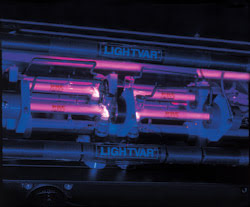Kevin Laughlin, PRC Laser
In manufacturing applications from welding to cutting and powdered metal deposition, the thirst for laser power is pushing CO2-based laser machining systems to higher power levels. As laser source technology advances, a need to harness this power efficiently is driving almost parallel advances in machine tool support systems, such as machine motion control, high-pressure assist-gas delivery controls and high-flow cutting-nozzle technology. And in turn, this momentum is expanding applications.
It wasn’t that long ago that 4 kW of output power was considered to be pushing the envelope for conventional industrial CO2 laser processing. Today, however, many end users have come to think of this as the minimum power level required to stay competitive in the industry. This is particularly true of CO2 laser systems in the fast-axial-flow category that have been the dominant workhorse of the laser industry for nearly 20 years. The manufacture and design of the technology has been refined such that, from an initial capital investment standpoint, it represents the lowest cost per watt in the laser marketplace.
With increasing demand for power, fast-axial-flow lasers between 6 and 8 kW are becoming commonplace. Currently, competitive slab technology is limited in power to about 4 to 5 kW for most applications. The beam quality of fast-axial-flow lasers makes them a more diverse manufacturing tool for all applications, allowing users to realize maximum processing benefits across a wider range of material types and thicknesses. Although slab technology offers a higher beam quality, the tangible benefits are usually seen only within a small range of material thicknesses.
On the machine tool front, linear motors have become fairly standard motion control drives for the latest generation of machine tool platforms. Advances also have been made in high-pressure assist-gas technology for cutting applications. As little as four years ago, applications were limited both by the pressure and by the flow rate that could be delivered to the workpiece. Now bulk storage tanks can produce assist pressures in excess of 500 psi and at almost twice the flow rates. All of this progress has opened the door to the routine cutting of thicker materials; for example, the maximum thickness of stainless steel plate that now can be cut has increased to 6 to 32 mm.

High-power laser sources are providing metal fabricators with expanded processing capabilities for thick-section cutting, as well as the ability to process thin materials faster.
Cutting nozzle design also has advanced. Consider the processing of thick carbon steel plate, for which the ejection of molten material from the cutting zone is critical to achieving a quality edge. This requires careful control of oxygen flow into the kerf zone, something not always possible with a standard nozzle that has a single orifice. An annular nozzle, however, uses additional orifices surrounding the main one to facilitate precision control of gas flow to the work zone.
These developments have enabled system builders to use the added power that CO2 laser source suppliers are making available. This combination of technological advances is fueling productivity gains across diverse applications.
Over the long term, end users can expect to see more use of hybrid processing technologies as average laser processing power continues to rise to 6-kW levels and beyond. Hybrid trends arose out of efforts to combine laser processing with more conventional techniques such as plasma assist on the cutting side, and with plasma, MIG and TIG assist on the welding side. Such processes show promise to further increase productivity in cutting and to help bridge gaps and solve part fit-up problems in welding applications.
Meet the author
Kevin Laughlin is vice president of sales and marketing at PRC Laser in Landing, N.J.; e-mail: [email protected].